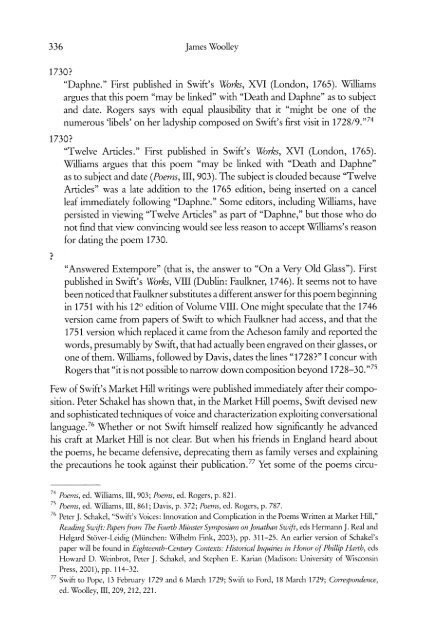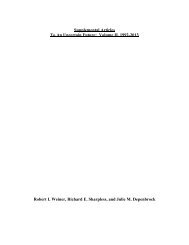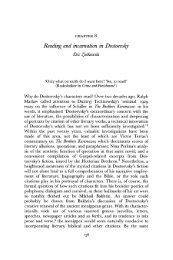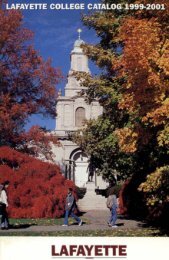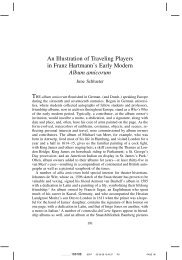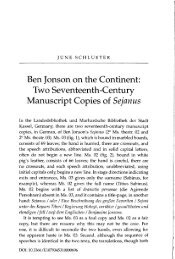Swift's “Skinnibonia”: A New Poem from Lady ... - Lafayette College
Swift's “Skinnibonia”: A New Poem from Lady ... - Lafayette College
Swift's “Skinnibonia”: A New Poem from Lady ... - Lafayette College
Create successful ePaper yourself
Turn your PDF publications into a flip-book with our unique Google optimized e-Paper software.
336<br />
James Woolley<br />
1730?<br />
“Daphne.” First published in Swift’s Works, XVI (London, 1765). Williams<br />
argues that this poem “may be linked” with “Death and Daphne” as to subject<br />
and date. Rogers says with equal plausibility that it “might be one of the<br />
numerous ‘libels’ on her ladyship composed on Swift’s first visit in 1728/9.”74<br />
1730?<br />
“Twelve Articles.” First published in Swift’s Works, XVI (London, 1765).<br />
Williams argues that this poem “may be linked with “Death and Daphne”<br />
as to subject and date (<strong>Poem</strong>s, III, 903). The subject is clouded because “Twelve<br />
Articles” was a late addition to the 1765 edition, being inserted on a cancel<br />
leaf immediately following “Daphne.” Some editors, including Williams, have<br />
persisted in viewing “Twelve Articles” as part of “Daphne,” but those who do<br />
not find that view convincing would see less reason to accept Williams’s reason<br />
for dating the poem 1730.<br />
“Answered Extempore” (that is, the answer to “On a Very Old Glass”). First<br />
published in Swift’s Works, VIII (Dublin: Faulkner, 1746). It seems not to have<br />
been noticed that Faulkner substitutes a different answer for this poem beginning<br />
in 1751 with his 12° edition of Volume VIII. One might speculate that the 1746<br />
version came <strong>from</strong> papers of Swift to which Faulkner had access, and that the<br />
1751 version which replaced it came <strong>from</strong> the Acheson family and reported the<br />
words, presumably by Swift, that had actually been engraved on their glasses, or<br />
one of them. Williams, followed by Davis, dates the lines “1728?” I concur with<br />
Rogers that “it is not possible to narrow down composition beyond 1728-30.”75<br />
Few of Swift’s Market Hill writings were published immediately after their composition.<br />
Peter Schakel has shown that, in the Market Hill poems, Swift devised new<br />
and sophisticated techniques of voice and characterization exploiting conversational<br />
language.76 Whether or not Swift himself realized how significantly he advanced<br />
his craft at Market Hill is not clear. But when his friends in England heard about<br />
the poems, he became defensive, deprecating them as family verses and explaining<br />
the precautions he took against their publication.77 Yet some of the poems circu<br />
74 <strong>Poem</strong>s, ed. Williams, III, 903; <strong>Poem</strong>s, ed. Rogers, p. 821.<br />
75 <strong>Poem</strong>s, ed. Williams, III, 861; Davis, p. 372; <strong>Poem</strong>s, ed. Rogers, p. 787.<br />
76 Peter J. Schakel, “Swift’s Voices: Innovation and Complication in the <strong>Poem</strong>s Written at Market Hill,”<br />
Reading Swift: Papers <strong>from</strong> The Fourth Münster Symposium on Jonathan Swift, eds Hermann J. Real and<br />
Helgard Stöver-Leidig (München: Wilhelm Fink, 2003), pp. 311-25. An earlier version of Schakel’s<br />
paper will be found in Eighteenth-Century Contexts: Historical Inquiries in Honor of Phillip Harth, eds<br />
Howard D. Weinbrot, Peter J. Schakel, and Stephen E. Karian (Madison: University of Wisconsin<br />
Press, 2001), pp. 114-32.<br />
77 Swift to Pope, 13 February 1729 and 6 March 1729; Swift to Ford, 18 March 1729; Correspondence,<br />
ed. Woolley, III, 209, 212, 221.


